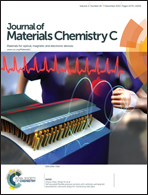Swift synthesis, functionalization and phase-transfer studies of ultrastable, visible light emitting oleate@ZnO quantum dots†
Abstract
Stable oleate capped, visible light emitting ZnO quantum dots (QDs) have been synthesized by a modified sol–gel method and examined for large-scale synthesis. Surface chelation with oleate ligands and their implications on particle growth were investigated by comprehensive NMR experiments and photoluminescence measurements. High-resolution electron microscopy and X-ray diffraction confirmed the high crystallinity and well-dispersed character of the ZnO QDs. The here investigated ZnO nanocrystals were found to be suitable for phase transfer synthesis (non-polar to polar dispersion medium) even after prolonged storage time that was verified by unchanged visible light emission. The absorption wavelength could be tuned by adjusting the nucleation kinetics and upon anchoring bulky ligands that provide control over the surface defects responsible for the optical (visible) properties. The demonstrated phase transfer studies make visible light emitting ZnO QDs accessible for a wide range of applications like ink-jet printing for nano-electronics, cell labelling or theranostic studies.


 Please wait while we load your content...
Please wait while we load your content...